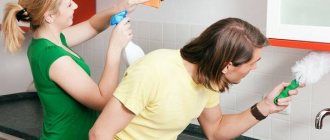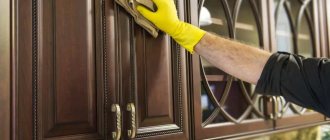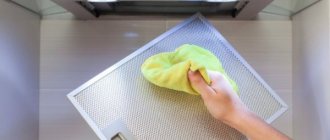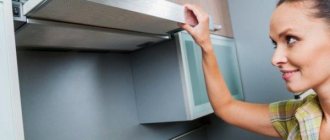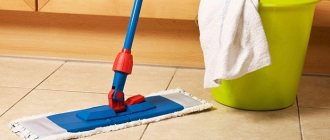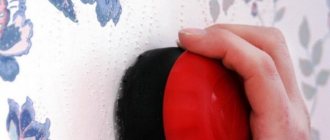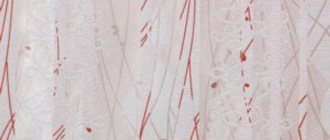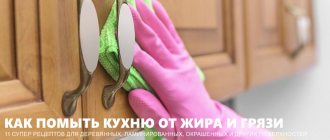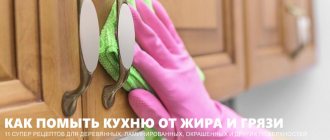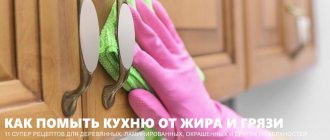The main causes of linoleum contamination
Linoleum is highly resistant to stains, but even it does not always cope with the effects of third-party substances. It is usually installed in rooms with special operating conditions (corridor, kitchen, balcony).
Top linoleum contamination that owners encounter:
- Oily spots. There is no place in the kitchen without them. Sometimes you can only deal with it by wiping the surface with a damp cloth, but sometimes you have to spend a long time and painfully scrubbing off the remaining grease.
Fighting greasy stains
- Shoes and traces from them . If this is an ordinary footprint with soil residues, cleaning will be quick, but for stripes from the sole or residues of creams and paints, you will have to look for an approach.
- Medicines. Iodine and brilliant green can also act as pests; it is not so easy to wash them off.
- Remains of repair work . Even with a very careful approach, it is difficult to carry out repairs and leave behind cleanliness. Polyurethane foam, cement, paints - all this remains on the floor.
- Rust and mold . If such contaminants are present, it will be necessary not only to clean the surface, but also to eliminate the cause - places of high humidity.
And also pay attention there is an article on the topic “How and how you can wash brilliant green from linoleum”
Also, owners of linoleum floors often have questions about why everything is fine in some rooms, while stains quickly remain in others. It all depends on the class of linoleum, its thickness, and most importantly - the condition of the top layer. If the coating is many years old and the protective layer has worn off, the stains will “take root” faster.
Resistance to stains depends on the condition of the protective layer.
Read more in the article “What thickness is linoleum?”
Iodine stains
This happens, especially in the kitchen, where you can often cut yourself with sharp objects. And iodine or brilliant green accidentally spilled on the floor past the wound instantly spoils all the beauty of the linoleum.
Starch removes iodine stains well. Wet the stain with water, and then rub the starch into it with a wet rag. Leave for at least 5 minutes, the iodine should be absorbed into the starch. If there are still small traces left after the starch, pour a little hydrogen peroxide onto the stain. Or repeat the procedure with starch.
Since potatoes contain starch, you can use either potato peelings or half a potato. Rub them onto the contaminated area and leave on it for another 20 minutes.
Another, no less serious remedy is a mixture of soda and vinegar. Sprinkle baking soda on the stain and add a little vinegar on top. If it doesn’t wash off, repeat the procedure or leave the mixture overnight and remove everything in the morning.
How to wash linoleum from dirt: what you should not do
Before you find out how to quickly clean linoleum, you need to find out which compounds should not be used. Nobody wants to get a dirty, damaged floor instead, so you shouldn’t use:
- Intensive solutions based on alkalis and soda. They are effective, but in large proportions they can damage the coating, making it brittle. These aggressive solutions should be used only in extreme cases and in recommended doses.
- Compositions for dissolving and bleaching. They should absolutely not be used; the chemicals contained in the solutions will damage the structure and color of the linoleum. Even after using solvents and bleaches, microcracks may appear.
- Products containing chlorine. At high concentrations, they will damage the top layer of the coating and lighten it.
You need to be careful when choosing funds
Advice. If a person is not sure that the chosen product can be used, then it is worth checking. To do this, a small area of linoleum is processed, which is not in plain sight (under a rug, under furniture, etc.).
It should also be taken into account that even seemingly harmless means can worsen the situation. Cleaning must be carried out strictly according to the rules. So, you can only use warm water, but not hot, and mix powder products very thoroughly so that their structure does not scratch the material.
Fighting stubborn dirt
How to wash dirty linoleum in the kitchen if the soap solution could not do it and more serious control measures are required? You can use formulations prepared at home. It is worth familiarizing yourself with each of them in order:
- Vodka. Add half a bottle of vodka to 5 liters of water. You can add additional powder or grated soap. Soak a rag in this solution and treat the problem spot. Then rinse thoroughly.
- Petrol. When using this substance, you must be extremely careful not to spoil the surface of the linoleum. Moisten a cotton swab and, without pressing, remove the stain with light movements. Afterwards wash with soapy water.
- Drying oil. A universal product that will not only get rid of dirt, but also restore a fresh look to linoleum. To remove stains, soak a cloth in drying oil. Treat the surface. Then pour it onto the linoleum and polish the area with a soft cloth.
To get rid of old stains, it is not necessary to use expensive cleaning products.
Effective stain removal
How effectively you can clean linoleum depends on the nature of the contamination. Based on the source of the problem, you need to take certain actions to prevent and eliminate it.
Household stains
In a room where people constantly live, it is impossible to avoid the appearance of pollution. Household stains include grease, food debris, dirt from shoes, dust, drinks and other substances. Usually it’s not difficult to deal with such stains, but when the stains get eaten, you have to work hard.
Regular cleaning will preserve the condition of the floor.
It is better to avoid such aggravations; for this it is recommended to take preventive actions:
- Provide additional protection in high-load areas. It is better to stick special rubber stickers on the legs of furniture and household appliances or lay a carpet;
- It is necessary to regularly clean the floor from dust, sweep it and vacuum it. Particular attention should be paid to corner areas where the most dirt accumulates;
- carry out wet cleaning at certain intervals. To do this, you can use ordinary warm water or non-aggressive soap solutions.
Video: effective ways to clean linoleum
Elimination of various substances
Various chemicals can become a real problem:
- Ink;
- brilliant green;
- paints and varnishes;
- alcohol compositions;
- rubber.
Ink is a tricky but solvable problem
Important. When a stain appears, you need to act quickly, wiping off as much of the substance as possible from the linoleum before it dries.
If the stain cannot be removed quickly, you will have to use chemicals or special cleaning products.
Cleaning after repair
After renovation work, most of the dirt and debris is on the floor. The simplest option is to avoid a large amount of contamination; for this, during repairs, it is better to cover the entire floor surface with newspaper or polyethylene.
If it was not possible to avoid contamination, then step-by-step cleaning should be carried out:
- First you need to collect large remnants of materials and sweep the linoleum.
- Dried putty residues are carefully scraped off with a spatula.
- Clean the whitewash with water or soap.
Advice. When washing floors after renovation, it is necessary to change the water several times so that it is not cloudy and does not leave streaks.
When the stains are very stubborn, you will have to use strong cleaning agents, for example, a solution of water and white spirit. When cleaning the remnants of the polyurethane foam, you need to carefully cut off its remnants with a knife without damaging the linoleum and cover with a wet rag so that the remnants get wet. If this does not help, you will have to use special means or Dimexide.
Removing polyurethane foam
Green spots
If the stain is very fresh, a soapy solution made with soap or washing powder can help. Wet the stain and gently wipe it with a cloth or sponge.
If it doesn’t help, or the stain is not that fresh, then use alcohol-containing products. This can be different types of alcohol: ammonia, medicinal, camphor. Or, as a last resort, the liquid that women use to remove nail polish will do.
A very old stain can be destroyed with a mixture of potassium permanganate and vinegar in a ratio of approximately 1 to 5. Apply the resulting solution to the stain, but do not rush to wash it off. Do this only when the greenery changes its color first to pink and then to brown. Finally, pour hydrogen peroxide onto the stain; this will completely discolor the brilliant green stain.
And another way for an old stain of brilliant green is to remove it with soda. Dip a damp cloth in baking soda and place on the stain for a few minutes. If a few minutes is not enough, increase to half an hour.
How to clean dirty linoleum
You can use special detergents for cleaning. Their advantage is that they are safe for the flooring material. TOP 3 funds:
- Torvan. Universal cleaner for floors, furniture, artificial leather. The product has a pleasant smell and can clean sticky areas of linoleum and some stains.
- Veriprop. Specialized composition for PVC floors. Just 40-50 ml of product per bucket of water and you will get an effective solution for cleaning stubborn stains.
Veriprop – reliable product Veriprop
- Sanytol. The product performs the functions of cleaning and disinfection, so it is suitable not only for residential but also for public spaces.
Every household chemical store has several options for both specialized and universal products.
What can be used besides special equipment
In addition to washing liquids, you can also use traditional methods. Their advantage is their targeted action; almost every type of stain has its own method of elimination.
Eraser
A regular eraser for pencils will help to cope with some stains, for example, marks from the sole of a shoe. This product can also be used to erase marker marks. After using the eraser, the surface must be cleaned with water or soap solution.
The eraser effectively removes small marks
Attention. An eraser can be used effectively only for small and narrow marks. It will do a great job with the streak left by the marker, but will not help in situations where it has run.
Matches
For small traces of ink, you need to use matches, or rather, their sulfur heads. They should be separated from the wooden rod and soaked. You need to rub the stain with the resulting mass, the reaction of sulfur and ink will solve the problem.
Match sulfur is also used for cleaning
Vodka
Old fat residue can be easily cleaned with vodka, but a certain concentration will be required. To prepare the detergent you will need a liter of water, 100 ml of vodka and a little dishwashing detergent. After treating the area of contamination, you also need to clean the floor from any remaining solution: rinse with water and wipe with a dry cloth.
Soda and vinegar
Vinegar is used to remove traces of yellow discoloration. It can be added to water when washing the floor, or applied neat to a cloth and placed on the stain. Adding baking soda will help remove iodine stains. But you need to be as careful as possible with soda, it can harm linoleum.
A tandem of baking soda and vinegar will help get rid of stubborn stains.
Tile cleaning products
It is used to clean floors from construction dirt and residues of various materials. But it should be noted that not all tile cleaning products will be harmless to linoleum, so it is better to check the reaction in an inconspicuous area.
Turpentine, kerosene, gasoline
Residues of iodine, ink, oils and paints can be cleaned with gasoline, turpentine or kerosene. But under no circumstances should you pour them onto the stain; cleaning occurs with a cloth moistened with the desired substance.
Bleach
Used in extreme situations, it helps solve problems such as rust contamination. In order not to harm the linoleum, you need to use bleaches without adding chlorine in the composition and in very weak proportions (1 tablespoon per bucket of water).
Bleach can only be used in small quantities
Mastic
Often used to remove adhesive traces of tape. Apply mastic only to the area of the stain. You should carefully choose the color; for new linoleums, light mastic is suitable, and the old rough coating can be treated with dark mastic.
Drying oil
It is used not so much for cleaning as for restoring appearance and protection. To do this, you need to wipe the linoleum with drying oil at least once every few months.
Drying oil adds shine to linoleum
Sauerkraut juice
Another folk method that has been around for decades. Sauerkraut juice quickly breaks down fats; after using it, all that remains is to wash the floor.
Elderberry porridge
If you don’t have the necessary funds at hand, you can find them on the street. Elderberry pulp is suitable for combating oily areas of the floor. It needs to be applied to the stain and then washed off.
Washing fat deposits
How to clean linoleum from grease if the stains are already so deeply ingrained that ordinary detergents cannot cope. Don't be upset. Even this problem can be dealt with.
The most effective way is to use mashed elderberries:
- Grind the berries in a blender.
- Apply the resulting mixture to the problem spot.
- Rub with a sponge.
- Afterwards, rinse thoroughly.
To remove more complex greasy stains, you need to use an alcohol solution:
- Dampen the cloth.
- Thoroughly wipe the area with stubborn grease.
- Then rinse with water.
Sometimes a problem arises that greasy deposits cannot be removed by ordinary cleaning products. How to clean linoleum in the kitchen from grease in this case? Turpentine must be used. But it is necessary to clean linoleum very carefully using this method in order to preserve the coating from damage. The cleaning method is the same as when using alcohol.
How to clean linoleum in the kitchen
Most dirt on kitchen floors is associated with grease and soot. You need to act in stages, first you need to wipe off as much dirt as possible with dry rags or a napkin. Afterwards, use a special one or one of the folk remedies. Dishwashing detergent is perfect for removing fresh stains; it will quickly break down fats.
It's important to act quickly
